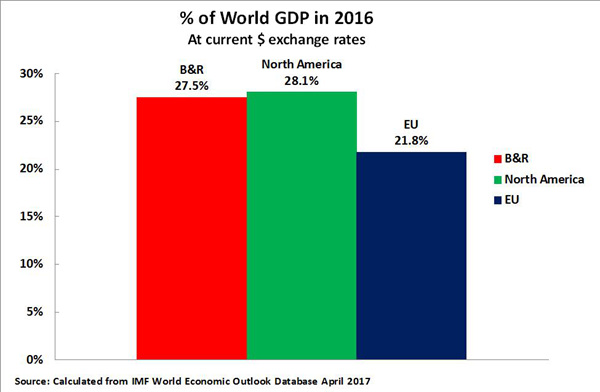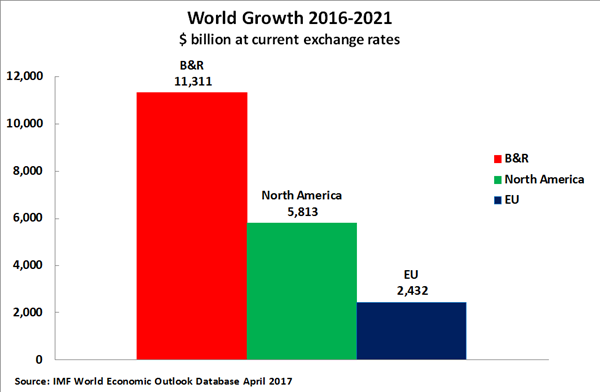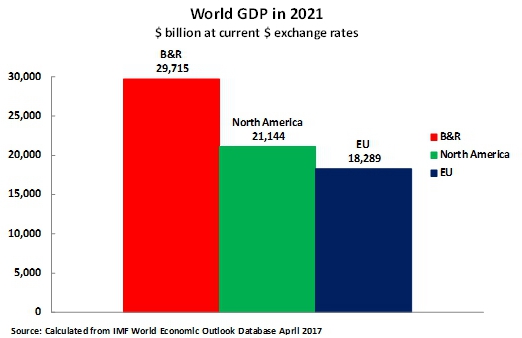Belt and Road
Your Present Location: PROGRAMS> Belt and RoadJohn Ross: The B&R`s regional growth potential is world`s greatest
By John Ross Source: China.org.cn Published: 2017-5-13
It is widely understood regarding the Beijing Belt and Road (B&R) summit on May 14-15 that the Belt and Road Initiative (BRI) is a decisive strategic project for China and participating countries. But it is still not widely grasped just how much greater the economic growth potential is in the B&R region compared to other world economic centers.
As will be shown, the B&R area has by far the greatest growth potential, both in percentage and absolute terms, of any major economic region – including North America and Europe.
Grasping the scale of the difference of the growth potential of the B&R region is crucial for understanding the full strategic significance of this initiative. This article therefore puts more precise numbers on the economic growth potential of the B&R region compared to the other major economic centers.
To demonstrate the full scale of the BRI`s potential, this article uses the IMF`s latest economic growth projections. It should be made clear that using these figures does not at all mean that they are being taken as a 100 percent accurate prediction of what will occur.
But the IMF projections clearly establish that growth in the B&R region will be very much higher than in North America or Europe. Entirely implausible assumptions of future development would therefore have to be made for the far stronger growth of B&R not to be strikingly apparent.
To avoid the suggestion of inflating numbers for the purposes of this article, the B&R region will be defined as China, member states of ASEAN, states of the former USSR except the Baltic States, all states in the Himalayas and Indian subcontinent, and in the Middle East; Iran, Iraq, and Turkey. Other states display strong interest in the BRI, including for example in Eastern Europe and the Middle East, but to avoid any suggestion of exaggerating figures these have not been included.
As B&R is a regional initiative in this article, data for North America, including Canada and Mexico, is given – rather than simply that for the U.S. For Europe, the European Union (EU) as a whole is taken. Given this framework then:
Measured at current exchange rates, projections from IMF data from 2016-2021 show the B&R region will account for 46 percent of world economic growth – compared to 24 percent for North America and 10 percent for the European Union.
If purchasing power parities (PPPs) were used, the differences in growth would be even greater. The B&R region would account for 58 percent of world growth – compared to 13 percent for North America and 11 percent for the EU. However, to avoid discussion of PPP measures, only economic projections at current exchange rates are used below.
The situation in 2016
As a starting point, Figure 1 shows that in 2016 the GDPs of the B&R region and the North American region were approximately equal in size while the EU was slightly smaller than either – B&R being equivalent to 27.5 percent of World GDP, North America 28.1 percent, and the EU 21.8 percent.

Growth potential
However, as the average growth rates in countries in the B&R region are much faster than those in either North America or the EU, the growth potential of B&R is much greater than those other centres. As Figure 2 shows, the IMF`s data projects an increase in GDP in the B&R region in 2016-2021 of $11.3 trillion – compared to $5.8 trillion in North America and $2.4 trillion in the EU.

Translating this into percentages of world growth, Figure 3 projects the B&R region as accounting for 46 percent of world GDP growth in 2016-2021 – compared to 24 percent in North America, and 10 percent in the EU. Therefore, almost one half of world economic growth in 2016-2021 is projected to occur in the B&R region – compared to less than one quarter in any other major economic center.
The growth potential of the B&R region, in both percentage and absolute terms, is therefore overwhelmingly higher than that of any other economic region – with a projected growth in dollar terms almost twice that of North America, and over four times that of Europe. This means the B&R region provides by a huge margin the most rapidly expanding market in the world.

The global economy in 2021
The reshaping of the world economy over the next five years by the B&R region is clearly the greatest of any part of the world economy. This reshaping of the world economy resulting from the B&R is shown clearly by Figure 4. By 2021, the GDP of the B&R region, calculated from IMF data, will be $29.7 trillion, compared to $21.1 trillion for North America and $18.3 trillion for the EU. In percentage terms the B&R region will be 31.3 percent of world GDP – compared to 27.3 percent for North America and 19.2 percent for the EU.

Conclusion
The above data naturally does not mean there are no problems facing the B&R region. The advantage of North America and the EU is that their per capita GDPs are much higher than the B&R region, and both NAFTA and the EU have an institutional structure which B&R region does not have nor is projected to have at present. The Beijing summit therefore has numerous tasks to work on not only its own projects but building and integrating existing initiatives. Such work is clearly an entire project lasting over a prolonged period.
But the far greater growth performance in the B&R region compared to any other, and therefore the vastly greater market expansion of the B&R region than any other, is a much stronger locomotive of the world economy than other relatively far less rapidly growing centers of the world economy.
The author is a Senior Fellow of Chongyang Institute for Financial Studies, Renmin University of China.
Key Words: Belt and Road; forum; IMF; John Ross























































































 京公网安备 11010802037854号
京公网安备 11010802037854号





